Story and Photos by Dave DeWitt
Fiery Foods & BBQ Central Recommendations
Chile Pepper Bedding Plants… over 500 varieties from Cross Country Nurseries, shipping April to early June. Fresh pods ship September and early October. Go here
Chile Pepper Seeds… from all over the world from the Chile Pepper Institute. Go here
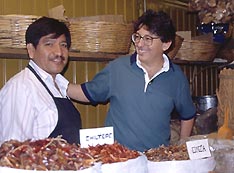
Eliseo Ramirez (left) and Jose Marmolejo
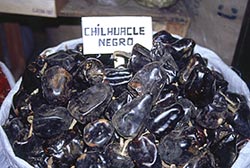
Chilhuacle Negro in Oaxacan Market
During the taping of my documentary video series, “Heat Up Your Life,” one of our shoots was in the mercado in Oaxaca in southern Mexico. With my friend Jose Marmolejo translating, I interviewed one of the chile vendors, Eliseo Ramirez, who told me that about sixty varieties of chiles were grown in Oaxaca and nowhere else in Mexico.As he showed me his chiles, I became fascinated with the varieties and learned that many of them were used in the famous mole sauces of the region. One of the chiles, the ‘Chilhuacle Negro’, is one of the main ingredients in mole negro, one of Oaxaca’s seven mole sauces. Needless to say, I devoted a large portion of my time in Oaxaca to devouring as many of those moles as I could. I remember that my favorite one was mole amarillo, which is a yellow mole that is made with ‘Costeño Amarillo’, a yellow- orange chile, 2 3/4 in. long, 3/8 in. wide].
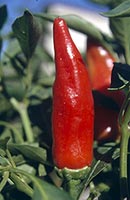
Chile de Agua
I brought back seeds from my trip to Oaxaca and grew out ‘Chile de Agua’, which apparently means “irrigated chile,” and it was an erect pod about 4 inches long and one inch wide. But the variety with the same name from Cross Country Nurseries was much different. The pods were pendant and measured 2 ½ inches long and one inch wide. Now I know that sometimes pods grow smaller when the plants are in containers, as mine were, but that didn’t explain the change in pod orientation. I suspect that there is a lot of variation in the pods because of the tendency of chiles to cross-pollinate.
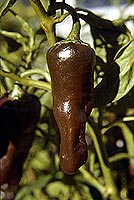
Pasilla de Oaxaca
In Oaxaca, I was told that the ‘Chile de Agua’ was smoked and then became known as ‘Pasilla de Oaxaca.’ However, some people insisted that ‘Pasilla de Oaxaca’ was a variety of pasilla(“little raisin”) that is smoked. The ‘Pasilla de Oaxaca’ from Cross Country resembled a short pasilla and it measured 2 ½ inches long by one inch wide.
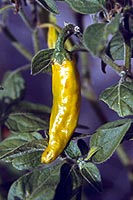
Onza
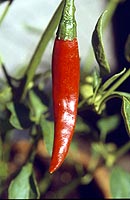
Pulla
Also called ‘De Onza’ (by the ounce), this ‘Onza Roja’ had attractive yellow pods that eventually turned red. The ‘Pulla’, also spelled ‘Puya”, is related to the ‘De Arbol’–indeed, its pods are nearly identical. Both of these chiles are used in Oaxacan moles.
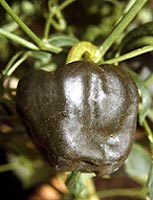
Chilhuacle Negro
Two of the Oaxacan chiles most commonly used in moles are the chilhuacles, black and red and both smaller than the ones I saw in the market. ‘Chilhuacle Negro’ measured just 2 inches long and 2 1/4 inches wide, while ‘Chilhuacle Rojo’ was 2 3/4 inches long and 1 ½ inches wide. The word “chilhuacle” seems to mean “crate chile,” as “huacal” or ‘guacal” is a vegetable crate. They appear to be related to anchos.
Plant Source:
Cross Country Nurseries, P.O. Box 170, Rosemont, NJ 08556-0170; www.chileplants.com
Email: janie@chileplants.com
Additional Reading and Recipes:
The Food and Life of Oaxaca: Traditional Recipes from Mexico’s Heart, by Zarela Martinez. New York: Macmillan, 1997.
Seasons of My Heart: A Culinary Journey Through Oaxaca, by Susana Trilling. New York: Ballantine Books, 1999.
![]() Chilhuacle Negro
Chilhuacle Negro
Chilhuacle Rojo ![]()
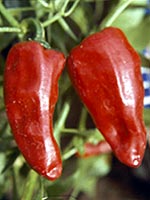
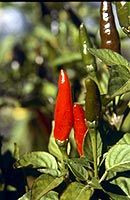
![]() Xigole
Xigole
Del Diablo ![]()

As might be expected, the piquin pod type is well-represented all over Mexico and Oaxaca is no exception. The two here probably began their existence as wild varieties that were later domesticated. However, birds probably still spread some of the seeds, as they have for millennia. The ‘Xigole’ was a typical piquin, measuring 1 1/4 inches long and 3/8 inch wide, but the ‘Del Diablo’ (“from the devil”) was one of the smallest piquins I have ever seen, a mere1/4 inch long by 1/8 inch wide. And it was devilishly hot.
![]() Onza
Onza
Pulla ![]()




